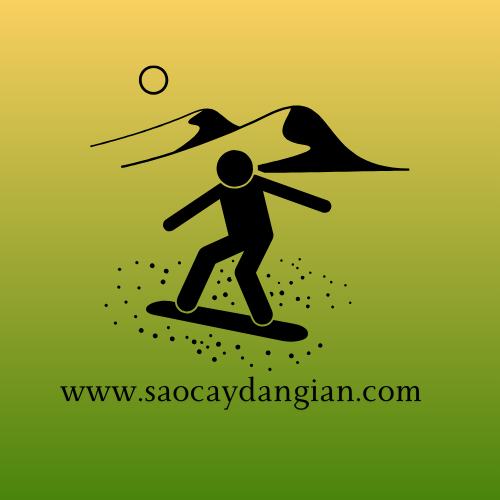
“How do you feel the difference between sandboarding and skiing? How does sandboarding compare to skiing?”
Differences in sandboarding and snowboarding experiences
Speed and surface
The experience of sandboarding and snowboarding has clear differences in speed and surface. While snowboarding allows players to achieve faster speeds due to the smooth and uniform surface, sandboarding creates more friction and often results in slower speeds. This makes a big difference in the skateboarding experience on these two types of surfaces.
Conditions and feelings
In addition to speed and surface, the conditions and feel of sandboarding and snowboarding are also different. Skiing usually takes place on snowy mountains in cold conditions, while sand skiing usually takes place on beaches in the sun. This creates a difference in the overall feel and experience of participating in these two types of activities.
Equipment and skills
Additionally, sandboarding and snowboarding both require different equipment and skills. Snowboards and sandboards have different designs and features to suit different surface conditions. In addition, skiing skills on snow and sand also require different adaptations and training to achieve the best performance.
What makes sandboarding and snowboarding different?

Terrain conditions
Sand skiing and snowboarding differ in terrain conditions. Skiing usually takes place on steep and well-groomed slopes, creating a smooth and even surface. Meanwhile, sandboarding often takes place on natural sand dunes, whose surface is uneven and unpredictable. This makes a difference in gaining speed and controlling skids.
Weather conditions
Weather is also an important factor that makes sandboarding and snowboarding different. While skiing requires an even surface of snow to create good sliding conditions, sand skiing can be affected by wind and arid weather conditions, affecting sliding and speed.
Board type and equipment
Both sandboarding and snowboarding use different types of boards and equipment. For example, snowboards are often designed to travel on smooth snow, while sandboards may have different properties to deal with unpredictable dune conditions. This creates a difference in the experience and skills required for each type of slide.
What is the difference between the feeling of sandboarding and skiing?
Terrain conditions
While sandboarding usually takes place on sand dunes and sand hills, skiing takes place on white snow covering hills and mountains. This makes a big difference in the feel of the slide. Sandboarding often feels soft and light, while snowboarding can feel powerful and fast due to its increased slipperiness.
Weather conditions
While sandboarding usually takes place in sunny and windy conditions, snowboarding usually takes place in cold and snow-covered conditions. This affects the feel of the slide, with sandboarding giving a tropical feel and snowboarding a cold and snowy feeling.
Degree of friction
The feeling of sliding also depends on the friction of the surface. Sand has more friction than snow, so sandboarding can feel slower and more controlled than skiing, where the slipperiness is higher and speeds can be quicker.
Sandboarding and skiing: Differences in feel
Differences in speed and friction
Sandboarding and skiing have obvious differences in speed and friction. While snowboarding allows players to achieve faster speeds due to the smooth and uniform surface, sandboarding causes more friction and often results in slower speeds. This creates a different feel when sliding on these two types of surfaces.
Differences in feel and technique
In addition to speed, feel and technique are also the differences between sandboarding and skiing. Snowboarding requires balance and independent foot movements, while sandboarding requires players to perform various rotations and balances to overcome high friction.
The difference in experience between sandboarding and skiing
Weather and terrain conditions
Skiing is often done on mountains with widespread snow cover, while sandboarding often takes place on sand dunes at beaches or deserts. This makes a big difference in weather conditions and terrain. Snowboarding usually requires more preparation with protective equipment and warm clothing, while sandboarding can be done in sunny and windy conditions without the need for too much protective equipment.
Experience speed
Snowboarding often offers a higher speed experience than sandboarding. The snow surface is smoother and more uniform than sand, allowing players to gain speed quickly on steep sections. Meanwhile, sandboarding can bring an exciting experience of sliding on smooth and smooth sand, but the speed cannot be compared to skiing.
What is the difference in feel between sandboarding and snowboarding?
Sand skiing
Sandboarding feels smoother and lighter than skiing. The sandy surface creates easy and comfortable sliding, helping players feel light when moving on the surface. In addition, the feel of the sand easily changes when sliding, creating excitement and challenge for players.
Skiing
While skiing, the player feels more powerful due to the harder snow surface and lower friction. The dynamics of the snow makes skiing faster and more powerful than sand skiing. In addition, the feel of the snow also changes depending on weather conditions and snow type, creating fun and variety in the skiing experience.
The feeling of sandboarding and skiing both bring unique excitement and challenges, depending on the preferences and skills of each player.
Sandboarding offers a greater sense of freedom than skiing. Expanded space and fine sand bring a new and more exciting experience to players.



